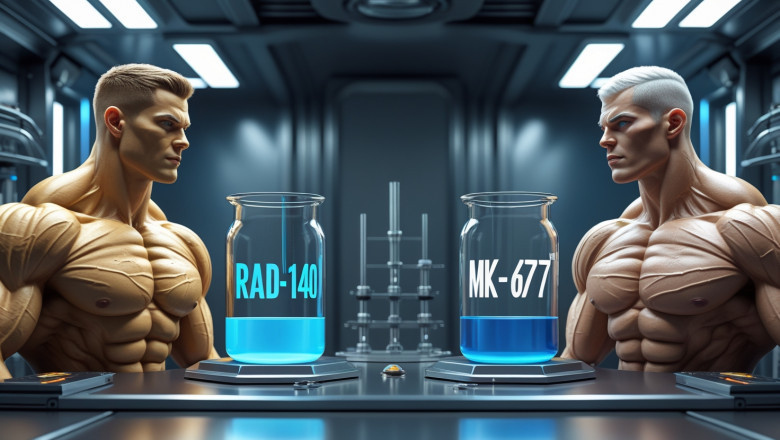views
When comparing RAD-140 and MK-677, it's essential to understand that these compounds serve distinct roles in muscle research. While both have gained traction for their unique mechanisms, their applications, effects, and research focus diverge significantly. Researchers often explore these agents for their anabolic properties, yet the pathways and outcomes they target vary widely. For those evaluating cutting-edge muscle research agents, this guide provides an in-depth comparison. For research-focused sourcing, RAD 140 for sale is commonly found through specialized suppliers catering to laboratory-grade compounds.
Understanding RAD-140: A Potent Selective Androgen Receptor Modulator (SARM)
RAD-140, also known as Testolone, is a selective androgen receptor modulator designed to mimic the effects of anabolic steroids without the associated side effects on non-muscular tissues. It binds selectively to androgen receptors in muscle and bone tissue, stimulating protein synthesis and promoting lean muscle mass in preclinical models.
In muscle studies, RAD-140 has shown promising anabolic potential with a strong affinity for androgen receptors. Unlike testosterone, RAD-140 doesn’t convert to estrogen or dihydrotestosterone (DHT), which may reduce the likelihood of unwanted side effects in controlled lab environments. Many researchers investigating SARMs before and after results report significant lean mass preservation and muscular enhancement without the hormonal volatility seen with steroids.
MK-677: Growth Hormone Secretagogue for Muscle Preservation and Recovery
MK-677, also known as Ibutamoren, functions as a growth hormone secretagogue. It mimics the action of ghrelin and stimulates the natural secretion of growth hormone (GH) and insulin-like growth factor 1 (IGF-1), both vital for tissue repair, muscle growth, and recovery.
In contrast to RAD-140, MK-677 doesn’t act on androgen receptors. Instead, it focuses on promoting the natural hormonal environment conducive to muscle hypertrophy and cellular repair. Researchers have documented enhanced recovery rates, improved sleep quality, and better skin elasticity in long-term studies. Its ability to elevate GH and IGF-1 levels makes it a popular compound in anti-catabolic muscle protocols.
MK-677 is often favored in research dealing with muscle-wasting conditions, where the preservation of lean body mass and increased GH output are critical. This distinguishes it as a tool for long-term regeneration studies rather than immediate hypertrophic responses.
Key Differences: Mechanism, Effects, and Research Applications
Researchers often compare these two compounds when evaluating hybrid protocols. Testolone is typically sourced for projects emphasizing muscle hypertrophy and strength output, while MK-677 is favored in regenerative or long-term anabolic support studies.
Potential Synergy in Combined Research Models
Some studies explore the combination of RAD-140 and MK-677 in tandem to assess synergistic effects. This dual approach leverages the androgenic activity of RAD-140 and the endocrine stimulation of MK-677 to potentially amplify muscle development while supporting recovery and hormonal balance.
In controlled models, researchers have observed improved nitrogen retention, enhanced endurance, and faster tissue regeneration when both compounds are administered concurrently. This has sparked further interest in combination protocols for muscle-wasting models and strength-focused studies.
Safety Profiles and Observational Data in Preclinical Environments
Both RAD-140 and MK-677 exhibit unique safety profiles. RAD-140, due to its selective action, typically avoids prostate and cardiovascular interactions in animal studies, while MK-677 has been associated with increased appetite and mild transient insulin resistance due to its GH-stimulating effects.
Observationally, RAD-140 may result in temporary suppression of endogenous testosterone in long-term studies, whereas MK-677 does not suppress natural hormone production but may alter glucose metabolism. Responsible study design, appropriate dosages, and regular biomarker tracking are essential to mitigating any adverse reactions in test environments.
Conclusion
The decision to pursue RAD-140 vs. MK-677 in muscle research depends on the study’s primary objective. For direct anabolic stimulation, RAD-140 provides powerful muscle-specific receptor activation. For hormonal elevation and enhanced tissue repair, MK-677 stands as a superior choice.
Each compound offers a unique avenue in muscle science, and understanding their respective mechanisms allows researchers to tailor protocols with precision and intent. When used strategically, both can serve as powerful tools in the evolution of muscle enhancement research.














Comments
0 comment